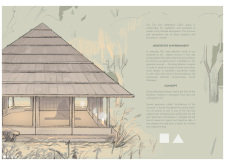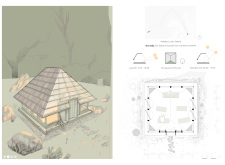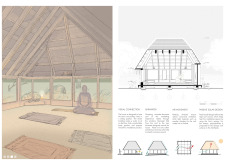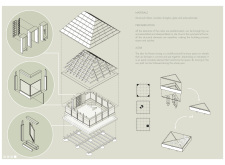5 key facts about this project
The primary function of the Tiny Kiwi Meditation Cabin is to provide a dedicated space for meditation and reflection. The design encourages users to immerse themselves in the calming essence of their surroundings, fostering a sense of peace that is vital for effective introspection. The layout has been carefully planned to allow for flexible usage, accommodating various meditation practices and personal preferences. With areas designated for individual contemplation as well as communal gatherings, the cabin reflects a versatile approach to design, focusing on both private reflection and shared experiences.
Architecturally, the cabin features a rectangular footprint that culminates in a elegantly sloped triangular roof. This form is not solely aesthetic; it symbolizes stability and harmony, inviting a sense of balance into the lives of those who use the space. The roof’s design facilitates water drainage while contributing to the overall visual appeal of the structure. It serves as a functional aspect, ensuring that the cabin seamlessly integrates with its natural environment. The use of high-quality timber for the structural framework, along with wooden shingles for the roofing, enriches the design with warmth and character, creating a comforting atmosphere.
Significant attention has been placed on the relationship between indoor and outdoor environments. The cabin features expansive glass windows that not only flood the interior with natural light but also frame picturesque views of the surrounding landscape. This integration of light and nature enhances the internal ambiance, making users feel more connected to the environment outside. Strategically placed openings allow for cross-ventilation, supporting natural airflow that contributes to the serene atmosphere essential for meditation.
The selection of materials used in the construction of the Tiny Kiwi Meditation Cabin is pivotal to its overall sustainability and architectural integrity. The choice of timber, glass, and polycarbonate goes beyond aesthetic considerations; it reflects a commitment to environmental responsibility. All components of the cabin are prefabricated, allowing for efficient assembly on-site, reducing construction waste and minimizing the environmental impact. This approach aligns the project with modern sustainable design principles, emphasizing ecological awareness in contemporary architecture.
The concept of passive design is central to the functionality of the cabin. By optimizing the orientation and shape of the structure, the design harnesses natural sunlight for warmth while maintaining thermal comfort. The carefully engineered roof and strategic window placements allow sunlight to penetrate deep into the interior, supporting a warm and inviting space for meditation even on cooler days. Moreover, rainwater management systems have been woven into the architectural fabric of the cabin, ensuring that the structure not only harmonizes with nature but also uses its resources wisely.
What distinguishes the Tiny Kiwi Meditation Cabin is its dedication to creating a space that fosters mindfulness through thoughtful architectural design. The integration of sacred geometry into the cabin’s form and function enhances the overall meditative experience. This design approach encourages users to reflect on their place within both the structure and the broader natural world, making every moment spent inside purposeful and enriching.
Those interested in a deeper exploration of this architectural project are encouraged to review the architectural plans, architectural sections, and architectural designs that illustrate the innovative ideas behind the Tiny Kiwi Meditation Cabin. Engaging with these elements will provide valuable insights into how this project harmonizes functionality with an introspective purpose, showcasing a contemporary approach to mindfulness through architecture.


























